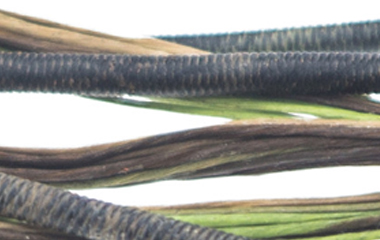Bowstrings 101
Understanding Bowstrings: Function, Construction, and Performance
 For those who might be new to the world of archery, a bowstring is the string used in a bow to launch an arrow into flight. While, to the uninitiated, bowstrings might seem like fairly nondescript and unremarkable lengths of twisted fiber, today’s bowstrings are the product of thousands of years of innovation and a far cry from the animal guts used to string together the first bows. Modern bowstrings are constructed using lightweight synthetic materials and state-of-the-art technology that offer performance superior to that of earlier types of bowstrings.
For those who might be new to the world of archery, a bowstring is the string used in a bow to launch an arrow into flight. While, to the uninitiated, bowstrings might seem like fairly nondescript and unremarkable lengths of twisted fiber, today’s bowstrings are the product of thousands of years of innovation and a far cry from the animal guts used to string together the first bows. Modern bowstrings are constructed using lightweight synthetic materials and state-of-the-art technology that offer performance superior to that of earlier types of bowstrings.
What (exactly) does a bowstring do?
The two primary functions of a bowstring are to a) transfer energy from the archer’s arms and back muscles to the limbs of the bow and b) to transfer energy stored in the bow to the arrow as it is sent into flight towards its target. The purpose of a bowstring can be thought of as roughly analogous to that of a golf club or tennis racket and, as with these instruments, materials and construction have a huge impact on performance. Just like how Tiger Woods or Vanessa Williams are particular about the equipment they take into a tournament, bowhunters and recreational archers have a lot to say about what their bows are strung with.
What Affects the Performance of a Bowstring?
There are a number of factors that affect the performance of a bowstring and the speed with which it can launch an arrow into flight. Along with the construction and design of the bow, the arrow itself, and the ability of the archer, the type of bowstrings can have a significant effect on an arrow’s ballistic performance.
In addition to performance, strength and durability are desirable qualities in a bowstring. Ideally, bowstrings should be as lightweight, strong, and durable as possible.
Factors that Affect the Performance & Durability of Bowstrings
Weight:
The weight of a bowstrings has a direct effect on arrow speed. Generally speaking, lighter bowstrings will transfer more energy to the arrow, allowing it to fly faster.
Serving:
Serving refers to the wrapping of fine threads of monofilament around the midsection of the bowstring where the nock set is. It is used to protect the bowstring from damage/abrasion that may occur when an arrow is nocked. The amount of serving will increase weight but also the expected life of your bowstring.
Twisting:
Bowstrings are generally made of strands of fiber twisted together. Twisting does not prevent creep but it does shorten the strings after it has occurred, thus somewhat “absorbing” it. Different bows have different numbers of twists per given string length.
Creep:
Creep is the permanent elongation of a bowstring that occurs after continual use. Creep is not to be confused with stretch–– which is temporary elongation that occurs due the degree of elasticity the bow is supposed to have. Creep can alter the factor specifications of a bowstring, increase or decrease its draw weight and draw length or cause other issues.
Materials:
The lightweight, synthetic fibers used to make today’s bowstrings are a huge improvement over natural plant fibers and animal sinew that were traditionally used to string bows. Materials like Dyneema®, Vectran, and others are often blended together to produce extremely strong and lightweight bowstrings that are resistant to water and don’t creep.
LEARN MORE
